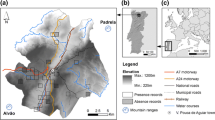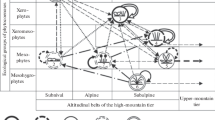Abstract
A new approach to modeling spatiotemporal dynamics in forest-steppe ecosystems amid climate change is proposed. This approach involves a morphometric analysis of the digital elevation model (SRTM). The resultant forecast is based on an analysis of the geological–geomorphological framework and takes into account the functional significance of specific relief forms and types and their impacts on the static and dynamic properties of ecosystems. Plain areas are most resistant to climatic changes, while areas with lacustrine relief are most vulnerable both under humidization and aridization conditions. Predictive mapping based on GIS and remote sensing (RS) data confirms the hypothesis of the focal–discrete nature of spatial changes observed in the forest-steppe zone of Western Siberia amid different climatic trends.





Similar content being viewed by others
REFERENCES
Arellano, G., Umaña, M.N., Macía, M.J., Loza, M.I., Fuentes, A., Cala, V., and Jørgensen, P.M., The role of niche overlap, environmental heterogeneity, landscape roughness and productivity in shaping species abundance distributions along the Amazon–Andes gradient, Global Ecol. Biogeogr., 2017, vol. 2017, pp. 191–202.
Bonney, M.T., Danby, R.K., and Treitz, P.M., Landscape variability of vegetation change across the forest to tundra transition of central Canada, Remote Sens. Environ., 2018, vol. 217, pp. 18‒29.
Chebakova, N.M., Reinfel’dt, Dzh., and Parfenova, E.I., Re-distribution of vegetation zones and populations of Siberian larch and Scots pine caused by climate warming, Sib. Ekol. Zh., 2003, no. 6, pp. 677‒686.
Chupina, D.A. and Zolnikov, I.D. GIS mapping of forms and types of a relief based on morphometric analysis, Geodez. Kartogr., 2016, no. 6, pp. 35–43.
Chupina, D.A., Zolnikov, I.D., Smolentseva, E.N., Lashchinskii, N.N., Nikulina, A.V., and Kartoziya, A.A., GIS mapping of the territory using the reaction on drought and moistening (south of West Siberian Plain), Izv. Ross. Akad. Nauk, Ser. Geogr., 2018, no. 5, pp. 81–90.
Ding, J., Johnson, E.A., and Martin, Y.E., Linking soil moisture variation and abundance of plants to geomorphic processes: a generalized model for erosion-uplifting landscapes, J. Geophys. Res.: Biogeosci., 2018, vol. 123, pp. 960–975.
Gabrielsen, C.G., Murphy, M.A., and Evans, J.S., Using a multiscale, probabilistic approach to identify spatial-temporal wetland gradients, Remote Sens. Environ., 2016, vol. 184, pp. 522‒538.
Glushkova, N.V., Chupina, D.A., Pchel’nikov, D.V., Boldyrev, I.I., and Selyatitskaya, N.A., Mapping and monitoring of aridization in the south of West Siberian Plain, Geogr. Prirod. Resur., 2016, no. 1, pp. 133–140.
Gopp, N.V., Analysis of quantitative characteristics of landscape components calculated using multizonal and radar survey, Sib. Ekol. Zh., 2007, no. 5, pp. 859‒869.
Gopp, N.V., Nechaeva, T.V., Savenkov, O.A., Smirnova, N.V., and Smirnov, V.V., Effect of slope mesorelief on the spatial variability of soil properties and vegetation index based on remote sensing data, Izv., Atmos. Ocean. Phys., 2019, vol. 55, no. 9, pp. 1329–1337.
Im, S.T., Kharuk, V.I., Rakityanskaya, N.M., and Golyukov, A.S., Climate-induced lake dynamics in the Trans-Baikal forest-steppe ecotone, Contemp. Probl. Ecol., 2015, vol. 8, no. 6, pp. 680–686.
Kolomyts, E.G. and Sharaya, L.S., Prognostic simulation of alpine ecosystems in view of global climate change, Russ. J. Ecol., 2012, vol. 43, no. 1, pp. 1–12.
Korolyuk, A.Yu., Dynamics of ecosystems in spatial structure of vegetation cover in the south of Western Siberia, Rastit. Mir Aziat. Ross., 2010, no. 2 (6), pp. 12–16.
Korolyuk, A.Yu., Communities of class Festuco–Brometea in West Siberian Plain, Rastit. Ross., 2014, no. 25, pp. 45–70.
Kulikov, A.I., Ubugunov, L.L., and Mangataev, A.Ts., Global climate change and its impact on ecosystems, Arid Ecosyst., 2014, vol. 4, no. 3, pp. 135–141.
Meyer, B.C., Schreiner, V., Smolentseva, E.N., and Smolentsev, B.A., Indicators of desertification in the Kulunda steppe in the south of Western Siberia, Arch. Agron. Soil Sci., 2008, vol. 54, no. 6, pp. 585–603.
Nikulina, A.V., GIS-based analysis of settlement patterns for the central Baraba Lowland (Western Siberia, Russia) in relation to climatic conditions of the Middle–Late Holocene, J. Archaeol. Sci., 2019, vol. 24, pp. 302–312.
Pomazkova, N.V. and Abakumova, V.Y., Analysis of the role of topography in the spatial differentiation of landscapes using geoinformation and statistical methods, Contemp. Probl. Ecol., 2018, vol. 11, no. 2, pp. 137‒149.
Pravalie, R., Sîrodoev, I., and Peptenatu, D., Changes in the forest ecosystems in areas impacted by aridization in south-western Romania, J. Environ. Health Sci. Eng., 2014, vol. 12, p. 2.
Rumiantsev, V.Yu., Malkhazova, S.M., Leonova, N.B., and Soldatov, M.S., Forecasting possible changes in zonal vegetation boundaries in European Russia and Western Siberia in connection with global warming, Contemp. Probl. Ecol., 2013, vol. 6, no. 4, pp. 343–349.
Sharaya, L.S. and Sharyi, P.A., Geomorphometric study of the spatial organization of forest ecosystems, Russ. J. Ecol., 2011, vol. 42, no. 1, pp. 1–8.
Struktura, funktsionirovanie i evolyutsiya sistemy biogeotsenozov Baraby (The Structure, Functions, and Evolution of the System of Baraba Biogeocenosises), Kovalev, R.V., Ed., Novosibirsk: Sib. Otd., Ross. Akad. Nauk, 1976.
Tziachrisa, P., Aschonitisa, V., Chatzistathisa, T., and Papadopoulou, M., Assessment of spatial hybrid methods for predicting soil organic matter using DEM derivatives and soil parameters, Catena, 2019, vol. 174, pp. 206–216.
Vinokurov, Yu.I., Landshaftnye indikatory inzhenerno- i gidro-geologicheskikh uslovii Predaltaiskikh ravnin (Landscape Indicators of Engineering and Hydrogeological Conditions of Altai Plains), Novosibirsk: Nauka, 1980.
Vtoroi otsenochnyi doklad Rosgidrometa ob izmeneniyakh klimata i ikh posledstviyakh na territorii Rossiiskoi Federatsii. Tekhnicheskoe rezyume (Second Assessment Report of Rosgidromet on Climate Change and Its Consequences in Russian Federation: Technical Summary), Moscow: Rosgidromet, 2014.
Wei, C., Dirk, K.N., and Wilson, A.M., Spatial detection of alpine treeline ecotones in the Western United States, Remote Sens. Environ., 2020, vol. 240, pp. 15–32.
Zhilich, S.V., Rudaya, N.A., and Krivonogov, S.K., Dynamics of vegetation and climate in the area of the Malye Chany Lake in Late Holocene, Din. Okruzh. Sredy Gobal’nye Izmeneniya Klim., 2016, vol. 7, no. 1, pp. 68‒75.
Zolnikov, I.D., Glushkova, N.V., Lyamina, V.A., Smolentseva, E.N., Korolyuk, A.Yu., Bezuglova, N.N., Zinchenko, G.S., and Puzanov, A.V., Dynamics of natural-territorial complex of the south of Western Siberia related with climate change, Geogr. Prirod. Resur., 2011, no. 2, pp. 155–160.
Zolnikov, I.D., Glushkova, N.V., Smolentseva, E.N., Chupina, D.A., Pchelnikov, D.V., and Lyamina, V.A., GIS and remote sensing data-based methods for monitoring water and soil objects in the steppe biome of Western Siberia, in Novel Methods for Monitoring and Managing Land and Water Resources in Siberia, Mueller, L., Sheudshen, A.K., and Eulenstein, F., Eds., New York: Springer-Verlag, 2016, pp. 253–268.
Funding
This study was performed as a part of the State Assignments of the Sobolev Institute of Geology and Mineralogy, Siberian Branch, Russian Academy of Sciences, and the Institute of Soil Science and Agrochemistry, Siberian Branch, Russian Academy of Sciences.
Author information
Authors and Affiliations
Corresponding authors
Ethics declarations
Conflict of interests. The authors declare that they have no conflicts of interest.
Statement on the welfare of humans or animals. This article does not contain any studies involving animals performed by any of the authors.
Additional information
Translated by L. Emeliyanov
Rights and permissions
About this article
Cite this article
Chupina, D.A., Zolnikov, I.D. & Smolentseva, E.N. Predictive Mapping of Spatiotemporal Dynamics in Subarid Ecosystems amid Multidirectional Climatic Wetting Trends. Contemp. Probl. Ecol. 13, 556–566 (2020). https://doi.org/10.1134/S1995425520050042
Received:
Revised:
Accepted:
Published:
Issue Date:
DOI: https://doi.org/10.1134/S1995425520050042




